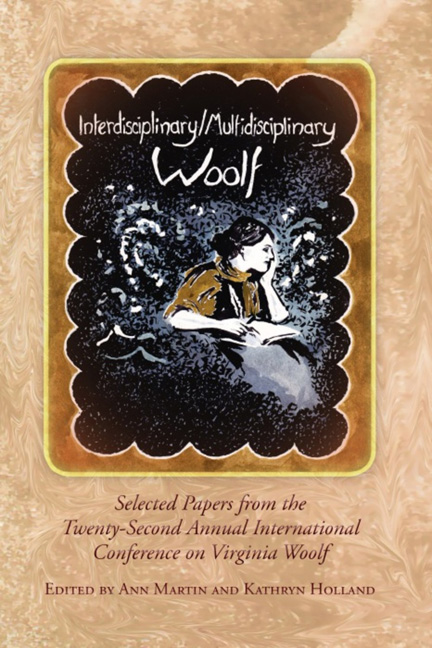Book contents
- Frontmatter
- Contents
- Introduction to Interdisciplinary/Multidisciplinary Woolf
- Acknowledgments
- List of Abbreviations
- History, Materiality, Multiplicity
- Patterns, Practices, Principles
- Art, Influence, Embodiment
- Publishing, Politics, Publics
- “The most unaccountable of machinery”: The Orlando Project produces a textbase of one's own
- The Hotel at the End of the Universe
- Globalization, Inter Connectivity, and Anti-Imperialism: Leonard Woolf, the Hogarth Press, and Kenya
- Chinese Eyes and Muddled Armenians: The Hogarth Press and British Racial Discourse
- “No One Wants Biography”: The Hogarth Press Classifies Orlando
- There Goes the Bride: Virginia Woolf, Julia Strachey, and the Hogarth Press
- Redefining Woolf for the 1990s: Producing and Promoting The “Definitive Collected Edition”
- The Believers: Writers Publishing for Readers, Or Preliminary Musings on The Hogarth Press and McSweeney's
- The Woolfs in Print and Online: A University Press in Transition
- Notes on Contributors
- Conference Program
There Goes the Bride: Virginia Woolf, Julia Strachey, and the Hogarth Press
from Publishing, Politics, Publics
- Frontmatter
- Contents
- Introduction to Interdisciplinary/Multidisciplinary Woolf
- Acknowledgments
- List of Abbreviations
- History, Materiality, Multiplicity
- Patterns, Practices, Principles
- Art, Influence, Embodiment
- Publishing, Politics, Publics
- “The most unaccountable of machinery”: The Orlando Project produces a textbase of one's own
- The Hotel at the End of the Universe
- Globalization, Inter Connectivity, and Anti-Imperialism: Leonard Woolf, the Hogarth Press, and Kenya
- Chinese Eyes and Muddled Armenians: The Hogarth Press and British Racial Discourse
- “No One Wants Biography”: The Hogarth Press Classifies Orlando
- There Goes the Bride: Virginia Woolf, Julia Strachey, and the Hogarth Press
- Redefining Woolf for the 1990s: Producing and Promoting The “Definitive Collected Edition”
- The Believers: Writers Publishing for Readers, Or Preliminary Musings on The Hogarth Press and McSweeney's
- The Woolfs in Print and Online: A University Press in Transition
- Notes on Contributors
- Conference Program
Summary
My title takes words linked to the ironic chorus from Wagner's Lohengrin and turns the bride around. “There goes the bride” implies an identity transformation— from unmarried to married. Yet, however idealized the rite of passage, the past remains ever-present, human tendencies to thwart perfection exist, and unpredictable realities of married life lie ahead.
Introduction: “a…remarkable acidulated story” —V. Woolf
What do brides and weddings have to do with the Hogarth Press? Not much overall, yet at least three books by women authors, published between 1928 and 1937, examine this event. The one that caught my eye was a first edition of Julia Strachey's novella, Cheerful Weather for the Wedding, published by the Hogarth Press in 1932, and still among the Woolfs’ books at Washington State University. To Clive Bell, Virginia described the manuscript as “a very cute, clever, indeed rather remarkable acidulated story” (L5 27). To Carrington, Julia's friend, Virginia wrote early in March 1932 that the manuscript was “astonishingly good…extraordinarily complete and sharp and individual” (L5 29). Hoping to distract Carrington from her grief after Lytton Strachey's death, Virginia tempted her with “scenes that want illustrations” (L5 29). Sadly, her effort failed to prevent Carrington's suicide. With no other illustrators in line for the job, Duncan Grant, Julia's cousin, agreed to design a jacket. (See illustration, below).
Although he thought it “poorly lettered,” in need of Vanessa Bell's color sense, and somewhat “vulgar,” Frances Partridge thought it “entirely appropriate” (Spalding, Duncan 317), and James Beechey calls it one of Grant's “most fluent” (19). The eye-catching jacket includes a floral bouquet, a white-gowned bride, and a blurb marketing the author as the late Lytton Strachey's niece. It is Julia's text, however—what Leonard Woolf calls “the immaterial inside of a book”—that evokes a mixture of absurdity and despair in the face of social expectations (Downhill 80).
What attracted Woolf, as fiction reader for the Press, to Strachey's story? Not unlike Julia's bride, Virginia thought she and Vanessa seemed fated to wed. When Vanessa, both “reluctant and yielding,” said, “’Of course, I can see that we shall all marry,’” Virginia felt “a horrible necessity” that would “descend…just as we had achieved freedom and happiness’” (MOB 192).
- Type
- Chapter
- Information
- Interdisciplinary/Multidisciplinary Woolf , pp. 247 - 255Publisher: Liverpool University PressPrint publication year: 2013



